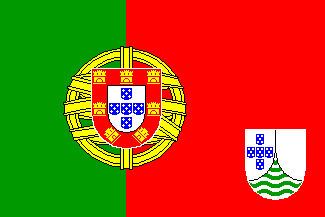
Last modified: 2014-06-29 by klaus-michael schneider
Keywords: colonial | coat of arms: escutcheons | coat of arms: per mantel | armillary sphere |
Links: FOTW homepage |
search |
disclaimer and copyright |
write us |
mirrors
The portuguese government’s position regarding the colonies has been almost since the 40ies that those were as part of the country as Lisbon. Therefore it made no sense (in their minds) to officialize flags for those territories other than the portuguese national flag. Two caveats must be made, though:
Normal people would use the word "colony", even if the official name was
"overseas province". In practice they didn’t work just any other province,
note: A normal portuguese was free to change lodgings from one to other
mainland province, but he would need a special document issued after an
official case analysis if he’d want to settle on overseas territory. I’m
not sure if this applied to tourism also, but it probably did.
António Martins, 30 Jan 2000

There was, however, a project to give the Portuguese colonies / overseas
provinces distinctive flags, but these were never adopted. The pattern for
these flags was: the Portugese flag with in the lower fly the shield of the
coat of arms of each territory. These coats of arms were
already in existence, and the shields of all consisted of two sub-shields,
dexter representing the motherland, sinister the territory, and the base
the oceans between them.
Mark Sensen, 30 Jul 1996
The heraldist F. P. de Almeida Langhans published in p. 67 of his
Armorial do Ultramar Português [lgh65]
(Lisbon, 1965) a general model for the overseas “provinces”’ flags: The
national flag defaced with the shield of the
lesser arms of each province (shield only) centered in the
lower fly quarter of the red field. This proposal was approved in 1967, but
never come to effect.
António Martins, 08 Jul 1997
It was a proposal seriously considered in governmental circles for some
time, to give distinctive flags to the “overseas provinces” as the regime
used to call them, but ultimately abandoned. The proposal made by Almeida
Langhans, a heraldist, was the hardly imaginative portuguese flag with the
colonial arms in lower fly. Unlike the flags, these
colonial arms where official and used in practice.
Jorge Candeias, 27 Jan 2000
col.gif)
The coats of arms of the portuguese colonies were introduced in 1935.
Two colonies were, however, using provisional arms before that. (Later all
colonies were transformed into overseas territories, but this did not have
any influence on arms.) All arms were of the same model: divided vertically
in such a way that two sub-shields are formed.
The dexter was white with five small blue shields each bearing five white
discs (i.e. the “quinas cross”
representing
the motherland). The sinister represented the colony. In the base green and
white waves to indicate the overseas location. To complete the badge, the arms
were set upon a golden armillary sphere with a golden mural crown.
Harald Müller, 05 Aug 1996
The colonial coats of arms, decreed on 8 May 1935, all had a shield of the
same pattern, tierced in mantel, the dexter silver, five escutcheons, saltire,
each charged with five bezants, gold, in cross; and the point silver, five
waves green. The remaining sinister mantel had some local emblem.
António Martins, 08 Jul 1997
Tierced per mantel 1 five quinas shields 2 the colony’s
specific coat of arms and 3 barry wavy of blue and white.
The crown had 5 apparent towers in each tower charged an armillary sphere
and in each space between towers charged a Christ’s
cross.
João Madureira, 04 Jun 2003
The crown used in these coats of arms was revived by means of the regional
arms design prescribed in the current law, though
the non existence of the said regions (refused in
referendum in 1999) make it defunct in practice
(it doesn’t even longer applies to East Timor
neither to Macao).
António Martins, 17 Dec 2001
The colonial sub-shields were:
cold.gif)
At a used books seller I found a print containing sketches of heraldical archievements for the old Portuguese colonies. These had a different pattern than those that ended up being adopted. These ones followed a more discreet pattern:
The colony’s specific coat of arms (by what I saw more or less the same as ended up being adopted with some exceptions) surrounded by a gold border whereby alternating were red Christ’s crosses and quinas shields. Topping them were crowns the details of which I didn’t white catch but I believe they were similar to the ones later adopted. (However I do not remeber these arms being supported by a large armillary sphere.)
The caption read that they were designed in 1932 by the Instituto Português de Heráldica for some Colonial Office. My question would be, are these arms known from any other sources? I guess they ended up not being adopted but may have served as initial inspiration to the later 1935 design. (IMHO, these versions would be quite better if they had been adopted. they give more proeminance to the specific colony and are clearer to see yet maintain some symbols of the metropolis.)
João Madureira, 04 Jun 2003
Anything below this line was not added by the editor of this page.